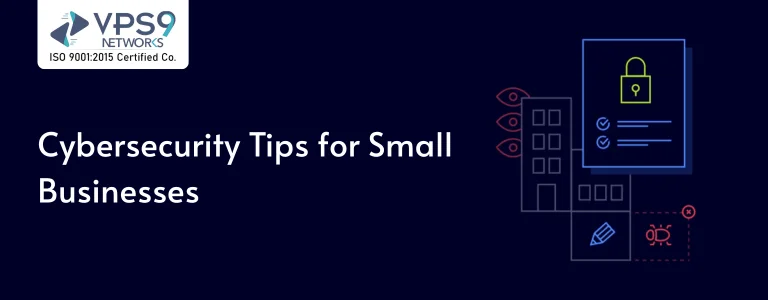Introduction
In today’s digitally-driven world, small businesses are as susceptible to cyberattacks as large enterprises, if not more so. Many believe their small size makes them uninteresting to cybercriminals, but this perceived obscurity is precisely what makes them appealing targets. Small businesses have little to no security infrastructure and often do not have a dedicated IT professional, making them susceptible to being targeted by cybercriminals.
Cybersecurity has moved from luxury to necessity. It has become an essential part of a modern business ethos. This post provides practical, actionable advice to small businesses to create a robust defense against cyberattacks.

Why Cybersecurity Matters for Small Businesses
Cyberattacks are increasingly frequent and sophisticated. While large multinational companies make headlines when attacked, small businesses often bear the brunt of cyber incidents. In fact, a report published in 2024 showed that 48% of all cyberattacks targeted small and mid-sized businesses.
The consequences can be substantial. In addition to the immediate financial loss, there are possible repercussions such as reputational damage, customer turnover, and even litigation. Compounding the issue, many small businesses lack the financial resources to recover from a major data breach.
Cybersecurity isn’t just about technology; it’s about protecting your customers, your employees, and your business’s longevity.
Why Cybersecurity Matters for Small Businesses
Recognizing threat types is the essential first step to defend against attacks:
- Phishing Scams
- Ransomware
- Malware
- Man-in-the-Middle Attacks (MitM)
- Password Attacks
Cybercriminals will often impersonate real businesses in emails or messages to trick employees into giving them private data or click on a malicious
Malicious software that encrypts a company’s data, often through phishing or unpatched systems, and asks for payment to release what they’ve locked up.
This includes viruses, worms, and trojans that get into your system and steal or destroy your data.
The attacker hacks data in transit, particularly over unsecure networks such as public Wi-Fi.
Weak or re-used passwords make it easy for a hacker to gain unauthorized access to business accounts.

Top Cybersecurity Tips for Small Businesses
- Educate Your Employees
- Strengthen Your Passwords and Use Multi-Factor Authentication
- Moreover, using multi-factor authentication (MFA) provides another layer of security. MFA typically requires a one-time code sent to your phone or generated by an authentication app..This way, if someone steals a password, they can’t get in without the next factor.
- Keep Systems and Software Updated
- Install Reliable Security Tools
- Secure Your Wi-Fi Network
Human error is a leading cause of security breaches. That’s why cybersecurity training must be prioritized for both employees and staff. Training should include education on identifying suspicious emails, being mindful of dangerous websites, and reporting observed suspicious behavior.
Training doesn’t have to be intense; in many circumstances, simple, short training or reminders once per month are sufficient. The key point is to make cybersecurity part of the work routine and work culture. Cybersecurity shouldn’t be a once-a-year, one-hour seminar.
Excellent analogy. No change needed. A secure password should be long, random, and unique for all accounts. Refrain from using any form of personal information or common phrases.
Outdated software often contains known vulnerabilities that hackers exploit to access your data and networks. It’s vital to receive updates and patches to keep your data safe.
Many cyberattacks simply occur because organizations delay patching their software. Automated software updates and patches for operating systems, web browsers, web browser plugins, and antivirus software help ensure an advantage over an organization’s attackers.
Firewalls create a barrier between your internal network and the internet, blocking unauthorized access. They must be configured correctly and reviewed frequently.
Similar to anti-virus software, anti-malware utilities facilitate the identification and containment of threats prior to their execution and damage to your business environment. Many free tools are available, but it is crucial you consider a trusted professional paid solution.
Ensure that your Wi-Fi network is password protected and encrypted. Open, unencrypted, or poorly secured networks using outdated protocols make it easy for attackers to gain access.
Default credentials should never be used for your router. Use strong custom passwords that only your employees can access. If you have visitors, it would be a good idea to set up a separate guest network for them.
Creating a Cybersecurity Culture
Security should be woven into the DNA of your business, not just implemented as a reaction to a breach. A robust security culture generates responsibility, transparency, and vigilance at all levels.
Make cybersecurity onboarding for new hires.Encourage employees to report suspicious activity without fear of blame. Reward good behavior and set an example.
When your team understands the risks and is empowered to act, your business is much more resilient.

Helpful Resources for SMBs
Numerous organizations provide free support and resources to help small businesses strengthen their cyber security:
The U.S. Small Business Administration (SBA) has specific cybersecurity guides for small businesses.
The Cybersecurity and Infrastructure Security Agency (CISA) offers free checklists, toolkits, and alerts.
Stay Safe Online, in partnership with the National Cyber Security Alliance, provides best practices and training materials.
You don’t have to face cybersecurity alone—leverage these free resources to bolster your defenses on a budget.
Conclusion
Cybersecurity is a critical business priority that no small business can afford to ignore. The risks are real. Yet so are the solutions. By taking proactive steps and nurturing a security-first mindset, small businesses can significantly reduce their risk.
The primary issues are to be educated, have diligence, and have the mindset of shared responsibility for securing data. It’s not about doing everything at once, chasing the latest tool, or hiring expensive IT staff. It is about laying down smart habits over time.
As the digital landscape shifts, think of how your defenses should shift too. Start now, and the future will thank you for it.



